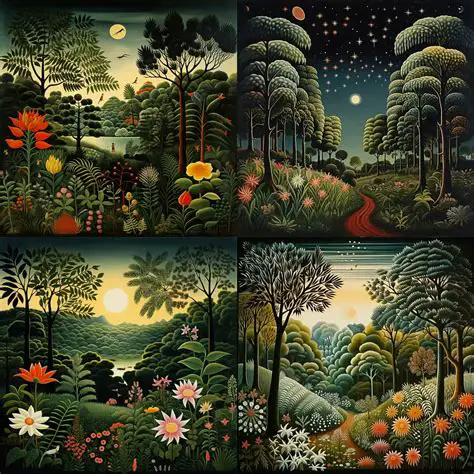Introduction
Henri Rousseau, the self-taught French artist, captivated the art world with his unique style that blended elements of primitivism, symbolism, and exoticism. His works, often featuring lush rainforests, exotic flora and fauna, and enigmatic human figures, have become iconic in the realm of modern art. This article delves into the distinctive characteristics, influences, and legacy of Henri Rousseau’s art style, exploring the enchanting world he created on canvas.

Primitivism and Exotica: The Essence of Rousseau’s Art
“For me, a landscape must be alive – something fantastic and beautiful. It should excite the imagination.” – Henri Rousseau
Rousseau’s art style is deeply rooted in primitivism, a movement that sought to emulate the art forms of non-Western cultures. He simplified shapes and forms, using flat colors and bold outlines, creating a sense of childlike innocence and wonder. His works often depicted exotic scenes of tropical rainforests, inspired by accounts of explorers and popular imagery of the time.
Symbolism and Allegory: Exploring the Hidden Meanings
Beyond its captivating visuals, Rousseau’s art is imbued with symbolism and allegorical meanings. He used animals and plants as symbols to convey emotions, ideas, and narratives. For example, lions represented strength and courage, while monkeys symbolized mischief and deception. The exotic landscapes themselves often served as metaphors for human experiences and the search for spiritual meaning.
The Outsider’s Perspective: A Unique Voice in Modern Art
Rousseau’s lack of formal training gave him a unique perspective, free from the constraints of academic conventions. He painted intuitively, relying on his imagination and observation. As a result, his works possess a raw, unpolished charm that resonates with viewers. His distinct style set him apart from his contemporaries, earning him the title of “the primitive modern.”
Influences and Inspiration: From Gauguin to the Fauves
Rousseau’s art was influenced by various sources, including the exotic paintings of Paul Gauguin and the vibrant colors of the Fauves. He also drew inspiration from his experiences as a customs inspector, where he observed a wide range of people and cultures. These influences combined to create a unique blend of primitivism, symbolism, and modernity in Rousseau’s works.
The Legacy of Henri Rousseau: An Enduring Enchantment
Henri Rousseau’s art continues to capture the imagination of viewers worldwide. His paintings have been exhibited in major museums around the globe, and his influence can be seen in the works of subsequent generations of artists. His unique style, blending the exotic and the primitive, has inspired creativity and sparked countless interpretations.
Henri Rousseau’s Art Style: A Deeper Dive
Primitivism: The Childlike Vision
- Simplified forms and bold outlines
- Flat colors and lack of perspective
- Childlike innocence and sense of wonder
Symbolism: The Language of the Unseen
- Animals and plants as symbols of emotions and ideas
- Exotic landscapes as metaphors for human experiences
- Allegorical narratives woven into the imagery
Modernity: A Radical Departure
- Intuitive painting and reliance on imagination
- Freedom from academic conventions
- Unique perspective of an outsider
Influence and Legacy: A Lasting Impact
- Inspiration from Gauguin and the Fauves
- Influence on subsequent generations of artists
- Enduring enchantment and continued fascination
Henri Rousseau’s Art Style: A Fountain of Artistic Discovery
Henri Rousseau’s art style is a testament to the power of imagination and the boundless possibilities of the artistic medium. His unique blend of primitivism, symbolism, and modernity continues to inspire and captivate viewers, leaving an enduring legacy in the world of modern art.
Useful Tables
Table 1: Henri Rousseau’s Key Works
| Title | Year | Description |
|---|---|---|
| The Dream | 1910 | A sleeping woman surrounded by a lush jungle |
| The Tiger’s Feast | 1891 | A tiger attacking a water buffalo in a tropical forest |
| The Snake Charmer | 1907 | A man playing music to a cobra in a dense forest |
| Landscape with a Farmhouse | 1896 | A serene countryside scene with a farmhouse and rolling hills |
Table 2: Influences on Henri Rousseau’s Art Style
| Source | Description |
|---|---|
| Paul Gauguin | Exotic paintings of tropical islands and primitive cultures |
| Fauves | Vibrant colors and expressive brushstrokes |
| Experiences as a Customs Inspector | Observation of diverse people and cultures |
| Popular imagery of the time | Illustrations of exotic plants and animals |
Table 3: Pros and Cons of Henri Rousseau’s Art Style
| Pros | Cons |
|---|---|
| Unique and captivating visuals | Can be seen as overly simplistic |
| Symbolic and allegorical meanings | Lacks technical finesse |
| Imaginative and childlike wonder | Can be difficult to interpret |
Table 4: Henri Rousseau’s Impact on Modern Art
| Movement | Influence |
|---|---|
| Primitivism | Simplified forms and bold outlines |
| Symbolism | Use of symbols to convey hidden meanings |
| Naive art | Childlike innocence and lack of formal training |
| Surrealism | Subconscious imagery and dreamlike landscapes |
FAQs: Henri Rousseau’s Art Style Unraveled
Q: What is the defining characteristic of Henri Rousseau’s art style?
A: A unique blend of primitivism, symbolism, and modernity, with simplified forms, bold colors, and exotic imagery.
Q: How did Rousseau’s lack of formal training influence his art?
A: It gave him a unique perspective, free from academic conventions, allowing him to paint intuitively and rely on his imagination.
Q: What is the significance of symbolism in Rousseau’s paintings?
A: He used animals, plants, and landscapes as symbols to convey emotions, ideas, and allegorical narratives.
Q: How has Henri Rousseau’s art influenced subsequent generations of artists?
A: His unique style and imaginative landscapes have inspired creativity and experimentation in various art movements, including primitivism, symbolism, and surrealism.
Q: Why is Henri Rousseau considered an important figure in modern art?
A: His art challenged traditional conventions, blended different artistic styles, and introduced a sense of wonder and imagination into the world of modern painting.
